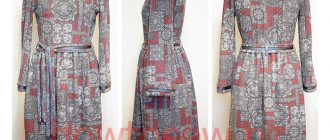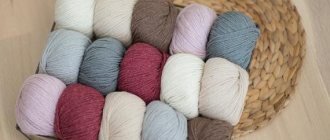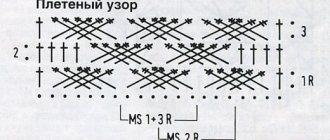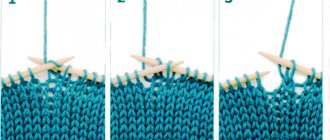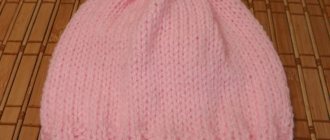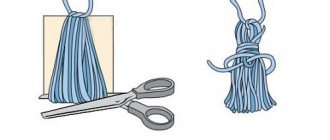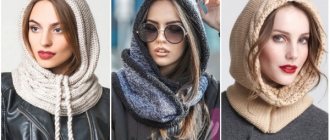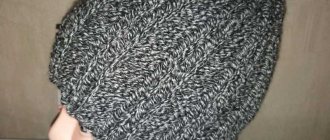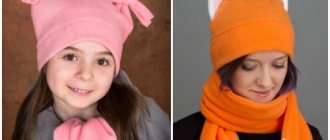Good afternoon. I propose to consider knitting a hat together with a pearl pattern with a 2 by 2 elastic band. In the master class I will tell you what dimensions you need to calculate before starting knitting, how to determine the height of the hat and the width of the knitting fabric. The pattern shows the nuances of knitting a 2 by 2 rib pattern and pearl knitting, and also describes the method of decreasing for a pearl pattern.
First, choose the yarn you will use to knit your hat. Choose according to your taste, but it is advisable to buy yarn with wool or 100% acrylic for a warm headdress.
- Easywool Ersur yarn 75% acrylic, 25% wool, 110 m, 100 g. PS for residents of Ukraine - this yarn is sold in ATB supermarkets.
- Knitting needles - No. 6 for rib and No. 5 for pearl pattern
- Meter for measurements.
- Needle for stitching.
How to knit a hat using stockinette stitch - diagram.
Stylish hat with pearl pattern
Stylish hat in an elongated shape
Let's start with the theory. Simple pearl pattern: (multiples of 2) 1 row: * K1, P1. * 2 r.: * 1 p., 1 knit. *
As you can see, everything is simple, above the faces.p. We knit the purl, and above the purl we knit the front one. In my story I will call the pattern either rice, pearl, putanka, or moss. Remember that they are the same thing.
There is also a double rice pattern: 1 p: * K1, P1. * Rows 2 and 4: according to pattern 3 rows: * Purl 1, knit 1. * The principle is the same, but reversed. R. you need to knit according to the pattern, and in faces. on the front - purl, above the purl - front.
I hope that it became clear to you and let’s start looking at what styles can be made with a rice pattern (pearl, moss, putanka).
For a gray hat with a pearl pattern you will need sp. No. 3.5, No. 3 and Drops Lima yarn (65% wool, 35% alpaca, 90m/50g). Model from Drops design studio. Density 21 p. = 10 cm
Rice pattern in the round: When knitting a hat on circular knitting needles, you should be sure to put a marker so you can see when the row changes. Follow the description of the simple pearl pattern (above).
Description of knitting a hat with circular knitting needles:
- Cast on 110/120 stitches. and tie 1 circle.r. facial pet.
- Next, continue with an elastic band 1x1 (k1, p1) 4 cm.
- Change the knitting needles to number 3.5 and knit knitted rice, evenly adding 8-10 sts for volume (=118/128 sts). If you don’t want such a voluminous hat, then don’t make an addition. Continue working until the height is 21-22 cm.
- In the original from Drops, you then need to switch to garter stitch (k1, purl 1), mark the segments every 10 stitches with markers. and make decreases after the marks, knitting 2 stitches. together in all facial areas (i.e. through the row) until 9-10 stitches remain. Pull them together with working thread and strengthen them.
- If you do not want to move on to garter stitch, but want to finish the hat with rice, then you need to do this: mark all the loops after 15 stitches. After each marker, knit 3 stitches together. Purl. or persons. - look at the alternation of loops. Repeat decreases after 2 p.
Size calculation
Before knitting a hat, you need to measure two parameters: the head circumference (HC) of the person for whom you are knitting, and the distance from the lobe of one ear to the lobe of the other (RUU) along the head through the top of the head. The second parameter is optional, it can be calculated using the formula, but if a person has a full haircut, then a larger hat may be needed, so it’s better to measure.
Let's say OG=56 cm, RU=42.
The width of the hat is equal to the circumference of the head. For elastic patterns, loose knitting or stretch yarn, subtract 1-2 cm from the head circumference.
The height of the cap (VSH) is equal to half the RUU (in the example 42/2 = 21 cm). Or you can calculate it using the formula using the head circumference 2+OG/3 (2+56/3=20.6 cm, rounded up = 21 cm).
Women's knitted hat with rice pattern
An elegant hat with a rice pattern.
A very feminine small hat, the hat is also knitted with a knot. For knitting, take medium density melange thread and number 6 knitting needles.
How to knit a woman's hat with a knot?
- Dial 21p. and tie the header fields first. 1st row: * K1, p1. * 2p.: * 1 p., 1 knit. * 3p: we knit like a tangle, but we don’t knit the row to the end, we knit 8p, and we throw the working thread onto the knitters. side, slip the loop from the left knitting needle to the right one, throw the thread onto the wrong side, as if wrapping around the loop that was re-snapped, and re-slip this loop back onto the left knitting needle (such wrapping is necessary so that there are no holes), turn the work and finish the reverse row with a tangle. Rows 5 and 6: tangle Repeat from rows 1 to 6 until the length on the short side is 46 cm. Cast off the loops.
- From the edge sts, cast on 72 sts. and knit a crown with pearl stitch 16 cm high.
- Start decreasing. To do this, hang the markers every 13 p. When knitting until separation, knit 3 stitches together with the loop (knit or purl) that goes in the order of the entanglement. If there is a knit stitch in front of the loops that you will be cutting, then purl the loops “together”. And vice versa.
- When 10-12 stitches remain, pull them off and secure..
When you knit a hat in the form of a hat, try to knit it tightly enough so that the product holds its shape
Rules for knitting men's hats
To make a man like a hat, you need to consider the following:
- Natural material is suitable for a hat, especially if your scalp is sensitive. Angora, cashmere, soft wool.
- The optimal knitting density should be determined. A properly knitted hat is tight, but does not cause discomfort and looks neat.
- The model must correspond to the time of year. A headdress with a pompom is good for winter; in spring or autumn it is better to choose a beanie hat.
- The color should be combined with the color scheme and style of the man's outerwear.
Melange overflow
Getting ready for a country walk
An unusually beautiful shade of yarn proposed by the designers of Verena magazine for a hat and scarf with a rice pattern. The same knitting was used. To get this shade, use a thread in four layers of different colors.
Size 52/55/58 cm You will need: – section-dyed yarn (70% alpaca, 30% sheep wool, 250 met/50g) – 50 g each of blue-green color (No. 1), yellow-green-orange (No. 2), blue-lilac-orange (No. 3) and green-yellow-raspberry (No. 4); – knitting needles No. 5.5
Density: 13 p. = 10 cm
Knitting pattern for a pearl knitted cap
- Cast on 60/62/64 sts with four folds of yarn (of different shades), evenly dividing them onto four double needles and combine into a ring.
- Knit 23cm with a simple pearl pattern (see at the beginning of the article).
- To round the crown, knit in the next row. all loops 2 at a time (=30/31/32p.). Pull these loops together with working thread and secure.
- Scarf: you will need 150 grams of yarn in each of four colors. Knit a rectangle measuring 40 by 130 cm.
Crochet
You can knit a hat for a man not only with knitting needles, but also with crochet. The process may seem more complicated, however, by following the description and understanding the diagram, you can create a beautiful product with soul.
Hook selection
The right tool is the key to beautiful work. Hooks can be long or short, depending on the type of knitting. You can find hooks made of metal, plastic, or combinations. The universal and most convenient hooks are made of steel. They do not smear the yarn, do not break, and are available in any size. The hook should be matched to the threads so that the product turns out neat and even.
Thin tools make the knitting tighter and vice versa. The sharp head can snag and separate the yarn fibers.
One of the selection methods is according to the table according to the length of the yarn. The shorter the thread per 100 g, the larger the hook size. You can select the hook manually: you need to tighten the thread in the recess of the tool head. The thread should fit in the beard without leaving any space or protruding.
Yarn selection
Crochet threads are selected based on the type of product and pattern. It is better to knit a sweater from a combination of thin and elastic threads to avoid an allergic reaction, and for accessories you can choose bright synthetic threads. The yarn should be uniform in thickness and strong.
Strongly twisted thread is not recommended; it will distort the pattern. If you want to use multi-colored or shaped material, the pattern does not have to be complex.
Pink beanie with turquoise stand
Fashionable youth beanie
The headdress is made in the now fashionable beanie style, with a slightly elongated shape. Size 55-57 cm, height 28 cm To make a hat, prepare: – pink Montego Linie yarn (60% wool, 40% polyacrylic, 100m/100g) – 100 grams; – remains of a turquoise hue; – double needles No. 6.5 and No. 8
Pattern for knitting a hat with a knot on knitting needles
- On the sp. No. 6.5 dial 60p. and knit 6 circles. rib 1x1 (k1, p1)
- Switch to size 8 needles and knit in a DOUBLE rice pattern (see description at the beginning of the article) to a height of 23 cm.
- Change the color to turquoise and knit 4 circles, purl 2 circles and finish with knit circles. At the same time, in every second row, knit every 3 and 4 stitches at once.
- When 15 stitches remain, tighten them and secure.
Knitting a simple men's hat in stockinette stitch with elastic
For beginners, it is better to choose a simple model in order to master the stages of knitting and not be disappointed in the process.
Yarn selection
It must be remembered that the hat will be worn by a man who may not like the thread with lint or glitter. The descriptions of most knitting patterns indicate the recommended threads for use and their thickness. If the store does not have the yarn you need, you can choose one with similar characteristics. The composition is also important.
Threads with a predominant content of natural fibers retain the original appearance of the product longer. Often natural and artificial threads are mixed, obtaining an advantageous combination of qualities. The choice of material also depends on the season. In winter, you should give preference to angora, goat down, and mohair.
Knitting needle selection
The main things to pay attention to are the size, shape and material of the knitting needles. The choice is also determined by the knitting style. The fabric is knitted in pairs with closed knitting needles, and both the fabric and products are knitted in the round without a seam. A set of stocking needles is used for seamless circular knitting of small items.
The size of the tools determines the density of the knitting and depends on the thickness of the yarn and the knitting characteristics of a particular person. Recommendations for selection are indicated on the thread packaging. It is worth considering that thick knitting needles will make the loops larger and looser, while thin knitting needles will make them tighter and tighter. The material and texture of the knitting needles depend on the yarn. For sliding threads you should choose rough ones, for fleecy ones - smoother ones.
Required measurements
Measurements for a hat must be taken directly from the head. You should not measure an existing headdress; the elasticity of the material may vary. You will need 2 main measurements: girth and height. The girth line is drawn above the eyebrows and a convex point on the back of the head. Height - the distance from the lobe to the parietal part.
The measuring tape should fit snugly to the head. Based on the characteristics of the model, other measurements may be needed. For a tight-fitting hat - from the crown to the end point of the future product on all sides; for a cap or earflaps - the circumference of the face.
Set of loops
To calculate the loops for the side, you need to knit a sample, stretch it a little, count the number per 1 cm and multiply by the head volume obtained from measurements. For patterns that tend to stretch, you can remove 2 cm. The amount for the main type of knitting is also calculated, without subtracting the stretch length.
There will be more loops. Extra loops are added immediately after the elastic, tying 2 loops from one at the same interval. The method of casting on loops determines the appearance of the edge of the fabric and its elasticity. It depends on the chosen pattern and model.
Scroll:
- Traditional . The edge is neat and moderately free. It is necessary to pull out a long tail of thread, 2 times the width of the product. The thread is placed so that the end goes around the thumb and lies above the segment stretched between the fingers, and the main part goes around the index finger. Both ends are squeezed with the ring finger and little finger. The knitting needles must be inserted from the bottom up under the thread on the thumb and placed behind the near part on the index finger, while removing the yarn from the thumb and tightening the loop.
- Air loops. For products with stretchy edges, hats, socks, sweaters. The first loop is made by hand. Next, take the knitting needle and warp thread in your left hand. The tail of the thread should be wound around the thumb from right to left. This way all the loops are formed. The loops are transferred to the knitting needle without tightening too much.
- The Italian set is also used to create a free edge. To make the first row denser, use smaller knitting needles. The first regular loop is performed. The tail should be 3 times longer than the finished product vertically. The thread must be stretched between the thumb and forefinger, cover the knitting needle with the part from the thumb. Then make a knit stitch by grabbing the second thread from top to bottom and pulling it under the first. For purling, the sequence of threads is changed. When the loops are cast on, knit 2–4 cm with an elastic band.
Main part of the header
Stockinette stitch is a simple type of knitting, the fabric is smooth and dense. The essence of the process is alternating rows of knit and purl stitches. When knitting knit stitches, the thread is located behind the fabric. The thread is grabbed and pulled out through the loop. For a purl loop, the thread is placed in front of the product and grabbed from right to left. The first loop is not knitted, the last one is knitted.
Knit to the crown, 16 - 18 cm, then begin to decrease the loops.
The final stage of mating
The number of loops is halved by knitting in pairs. It is possible to decrease through a row according to the pattern 5 in satin stitch, 2 together, reducing the number of stitches in satin stitch. When no more than 12 loops remain, the thread is cut, pulled through them and secured from the inside.


